Recent Articles
Popular Makes
Body Types
2016 Toyota Mirai Review and First Drive

2016 Toyota Mirai Silver Paint Front Quarter Left ・ Photo by Christian Wardlaw
Fuel cell vehicles are the future, and it’s time we all got used to the idea. Hydrogen – abundantly available and increasingly produced using wind and solar power rather than natural gas – goes in, and nothing but water vapor comes out. Clean, green, and a futuristic machine, the 2016 Toyota Mirai is a fuel cell vehicle representing the culmination of 20 years of research, engineering, and testing, and it goes on sale in about a year. Toyota expects to sell 3,000 of them to U.S. customers by the end of 2017.
Employing an appropriate metaphor, that’s barely a drop in the bucket in terms of overall market sales. But it is also more ambitious than what other automakers exploring fuel cell technology have either achieved or have announced (as this is written), and while it is fair to say that a fledgling infrastructure now appears to be the greatest obstacle to broader acceptance and appeal of fuel cell vehicles, price may still represent a significant hurdle, both in terms of development costs to car companies and in terms of what consumers are going to pay to drive a fuel cell vehicle
What's it Gonna Cost?
For most car buyers, the key question is “What’s it gonna cost?” Here’s the answer:
- Sticker Price: $57,500
- Lease: $499 per month for 36 months, with $3,649 due at contract signing and a 12,000-mile annual mileage limit
Yep, that’s a high price tag for what is a midsize sedan wearing a Toyota badge, but given the technology residing beneath the Mirai’s decidedly odd styling, it actually represents a bargain. Besides, that lease deal is comparable to what a decently equipped BMW 3 Series or Mercedes-Benz C-Class might run.
Toyota says that current federal, state, and local tax incentives can effectively reduce the price to about $45,000, but some of those are set to expire before the Mirai actually goes on sale, so consider that a best-case scenario. Also, hydrogen fuel is currently free, because nobody has figured out how to reliably regulate it, measure dispensation, and charge accordingly. That is underway, though, and ultimately the free fuel thing will evaporate as quickly as the water vapor emitted by the Mirai’s exhaust system.
Beyond price, payment, and fuel, there is the issue of insurance. Toyota says it is working with both Allstate and State Farm to ensure that Mirai owners can insure the car at reasonable rates. The automaker’s liberal use of off-the-shelf components helps to keep replacement costs down for all but the priciest of the fuel cell components, which are well protected and located beneath the seating positions.
Additional enticements include free high-occupancy vehicle (HOV) lane access in California, where the Mirai will first be available. In other words, you get to use the carpool lane even if you’re not carpooling. Toyota also provides what it calls a 360-degree Ownership Experience package that includes free maintenance, free roadside assistance, and dedicated concierge services for the first three years of ownership. The fuel cell powertrain is warranted for eight years or 100,000 miles, whichever comes first, and Toyota says the fuel cell technology is designed to reliably serve owners for 150,000 miles.
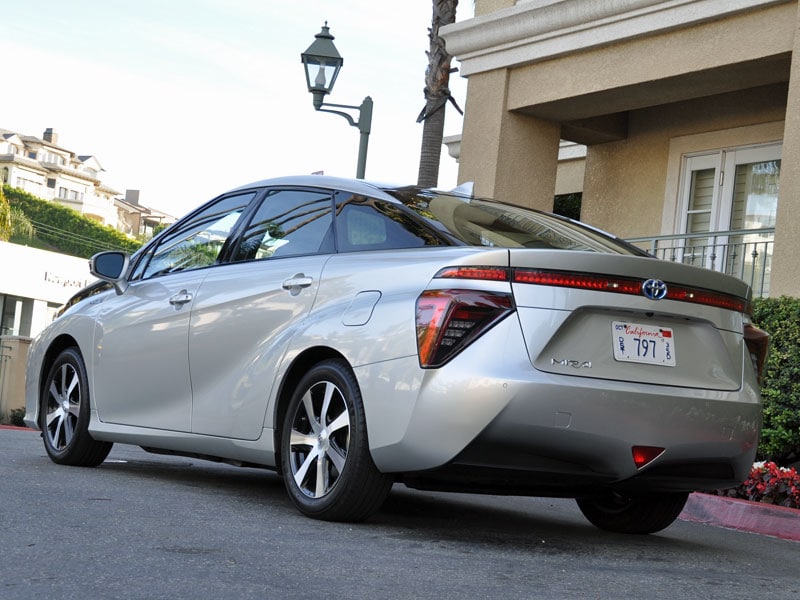
Photo by Christian Wardlaw
What's Under the Hood?
Simplistically speaking, a fuel cell vehicle is an electric car that never needs to be plugged in. Instead, it runs on compressed hydrogen gas. The gas is converted into electricity with a fuel cell stack, with water vapor the byproduct of the process. The water vapor is emitted from the vehicle, and the electricity flows through a battery pack to power an electric drive motor.
The benefits are obvious. Hydrogen is the most abundant element in the universe, and hydrogen gas is increasingly made using solar, wind, and even sewage treatment processes rather than natural gas. But even when natural gas is employed to create the hydrogen to power a fuel cell vehicle, fossil fuel emissions from production to consumption are approximately half that of gasoline because hydrogen gas is already used in the production of gasoline.
In the 2016 Toyota Mirai, the compressed hydrogen gas is stored in carbon fiber tanks located under the rear seat, and described as “bulletproof.” The fuel cell stack under the front seats converts the hydrogen gas into electricity, which charges a 650-volt nickel-metal hydride battery pack, which then powers an electric motor making 151 horsepower and 247 lb.-ft. of torque. The torque is available instantly, the moment the driver steps on the accelerator pedal, and Toyota says the Mirai accelerates to 60 mph in about nine seconds and can achieve a top speed of 111 mph.
As this is written, the EPA has not generated an official miles-per-gallon-equivalent for the Mirai, but Toyota expects the car to provide a 300-mile driving range between visits to the hydrogen station.
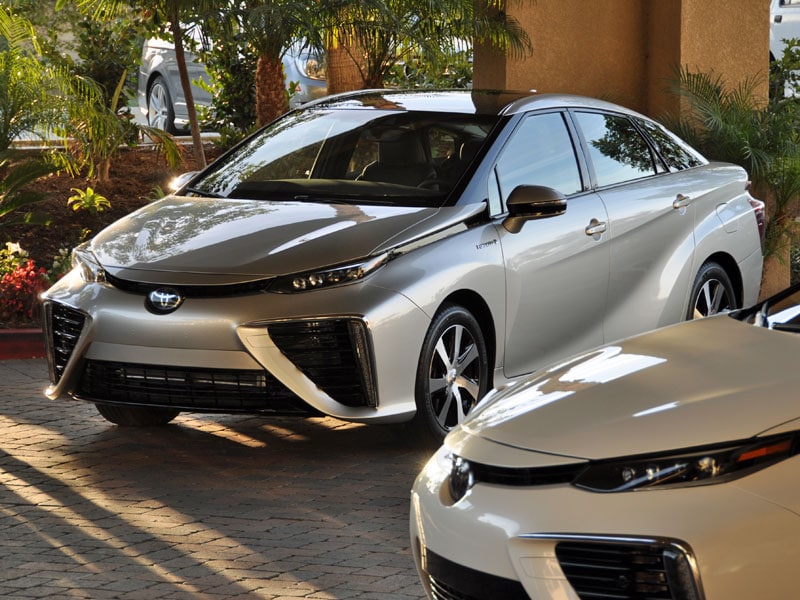
Photo by Christian Wardlaw
Driving Impressions
Get into the 2016 Toyota Mirai, and you’re faced with touchscreen infotainment and climate control panels, a strip of electronic gauges and displays, and an array of traditional buttons and switches. Anyone familiar with a modern Toyota or Lexus will be right at home. Push the start button, select Drive, and the Mirai silently glides forward, feeling and sounding just like the electric car that it is.
Granted, my time behind the wheel was short, but after slogging through Orange County, Calif., morning rush hour traffic with three other passengers aboard, the Mirai is no different to drive than any other electric car.
Thanks to all the torque available from the minute a traffic light turns green, acceleration is not an issue, the Mirai gaining velocity in silence except for a faint electrical whine. It effortlessly cruises on the freeway, and the electric steering feels as though it gains heft with speed, feeling remarkably sure on-center and appropriately responsive off-center.
Exiting the freeway, the regenerative braking system takes some getting used to, which is true of all such setups. Acclimation comes quickly, though occasionally jarring stops are impossible to eliminate. The driver can choose between an Eco driving mode and a Sport driving mode, and there is an appreciable difference between the two.
With so much weight snugged down low in the Mirai’s platform, the car feels solidly planted on freeway ramps and on curvy stretches of suburban boulevards. Additionally, when my co-driver executed an evasive move in traffic, the Mirai securely avoided disaster.
During this brief encounter with the Mirai, the only thing concerning me was the trip computer display showing that during the course of a short drive the car returned about 46 MPGe at an average speed of about 25 mph. Yes, there was traffic. Yes, my test car carried four sizable dudes. But still.
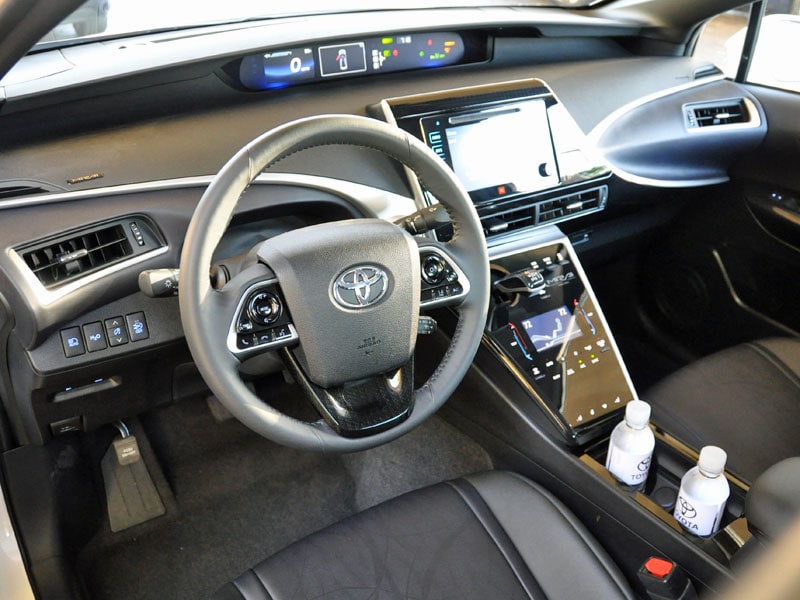
Photo by Christian Wardlaw
Practical Matters
Equipped with four comfortable seats, two center storage consoles, and a midsize cabin, the Mirai easily handles adult occupants in each seating location. The trunk is sizable too, and while it doesn’t fold, it certainly holds enough luggage for a long weekend road trip…provided there are hydrogen filling stations where you’re headed.
We visited an existing hydrogen gas pump located in Orange County, where hydrogen gas is manufactured at a sewage treatment facility. Pop the Mirai’s fuel door open, remove the plastic nozzle cap within, push the hydrogen pump into the nozzle and lock it, and then proceed in similar fashion to how a traditional gasoline pump works. In five minutes, the Mirai’s depleted hydrogen tanks are replenished.
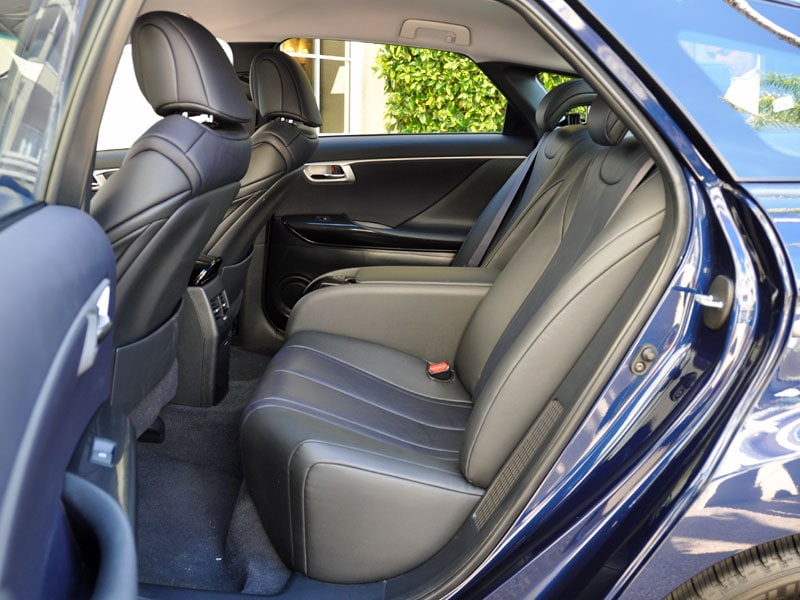
Photo by Christian Wardlaw
Final Thoughts
Progress is not easy. During the presentations surrounding the Mirai’s introduction to journalists, Scott Samuelson, director of the National Fuel Cell Research Center, likened what may ultimately prove as the turning point for modern mobility to the introduction and slow adoption of the automobile in favor of horse-drawn carriages.
Lots of people had horses. Nobody had automobiles. Gasoline was inconvenient. Yet society ultimately embraced four-wheeled conveyances equipped with combustion engines.
More than 100 years later, the shift in the form of mobility is not as dramatic, but is of equal importance. Fuel cell vehicles like the 2016 Toyota Mirai, despite its outlandish styling, are comfortably familiar in terms of their appearance and packaging, unlike when people migrated from horses to automobiles in the first place. What’s underneath the surface, though, and what’s required in terms of a fueling infrastructure to support fuel cell vehicles, is different. And the cleansing effect on the environment is not unlike the refreshing elimination of horse crap on streets.
As Satoshi Ogiso, Managing Officer of Toyota Motor Corporation, told journalists gathered from around the world to drive the new Mirai, which translates to “future” in Japanese: “Sometimes, change takes persistence and the long view.”
The implication, of course, is that Toyota is committed to fuel cell technology. Consumers and their government representatives now need to decide whether or not they’re willing to accept it, and to pay for it.
Toyota invited Autobytel to a media event to review the 2016 Mirai
2016 Toyota Mirai photos by Christian Wardlaw
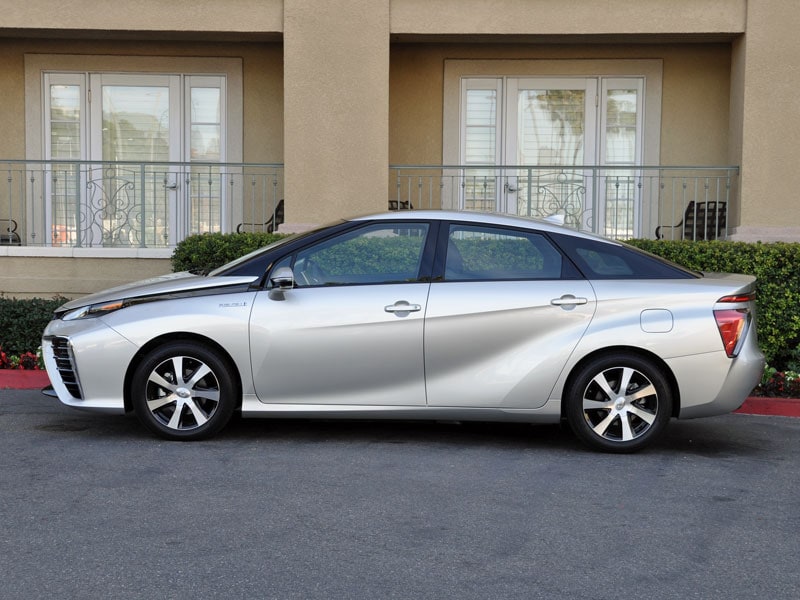
Photo by Christian Wardlaw